Analysis of Lateral Pile-Ground Interaction - 9B01
| Project Title—ID Number | Analysis of Lateral Pile-Ground Interaction - 9B01 |
| Start/End Dates | 10/1/05 – 9/30/06 |
| Funding Source | PEER-Caltrans |
| Project Leader (boldface) and Other Team Members | Ahmed Elgamal (UCSD/F), Jinchi Lu (UCSD/PD) |
Project goals and objectives
The main goal is to develop a 3-dimensional finite element analysis tool for use by practice to estimate seismic lateral loading effects on piles and large diameter piers Figure 1). This tool, OpenSeesPL, will allow for the execution of single pile and pile group simulations under seismic excitation scenarios as well as push-over situations.
Role of this project in supporting PEER's mission (vision)
Provide an interface for efficient utilization of an OpenSees high end computational tool for a wide class of applications in seismic Bridge-ground analyses, and similar ground-structure situations.
Methodology employed
Scenario-specific Windows-based user interface for pre- and post- processing, driven by the OpenSees Computational Platform.
Brief Description of previous year's achievements, with emphasis on accomplishments during last year (Year 8)
New Project
Other similar work being conducted within and outside PEER and how this project differs
OpenSees development efforts include development of user-interfaces by other PEER researchers, and through national collaborative efforts led by Professor Greg Fenves.
Describe any instances where you are aware that your results have been used in industry
New project aimed at facilitating the use of OpenSees by the research and practicing communities.
Expected milestones & deliverables
The anticipated long-term project will eventually cover:
The overall effort will eventually allow the interface to cover:
- Circular piles and large diameter piers embedded in uniform or layered ground profiles.
- Square piles or large piers embedded in uniform or layered ground profiles.
- Pile groups in level ground.
- Pile or Pier in sloping ground.
- Pile group in sloping ground.
- Push over analysis in 1 lateral direction.
- Push over analysis in 2 lateral directions.
- Response due to seismic excitation in one or two lateral directions.
- Availability of graphical output in a word file for use in writing report.
- Linear and nonlinear soil properties.
- Linear pile properties (reinforced concrete, cased piles, or steel).
- Nonlinear pile/Pier properties using fiber discretization (reinforced concrete, cased piles, or steel)
- Nonlinear pile properties with nonlinear moment curvature relation (reinforced concrete, cased piles, or steel).
- Pile/Pier will bridge deck included.
- Analysis of Liquefaction Scenarios and countermeasures.
- Inclusion of pile-soil interface boundary elements.
Tasks 1, 2, 6, 7, 10, 11, 13, and 14 will be complete by May 2006.
ACCOMPLISHMENTS
Tasks 1, 2, 6, 7, 10, and 11 were complete by March 2006. Sample dialog windows of OpenSeesPL are shown in Figures 1-7. In OpenSeesPL, definition of pile dimension and material properties is an important element. In this interface, pile cross section can be circular (Figure 2, Task 1) or square (Figure 3, Task 2). The interface can generate meshes for piles in slopes, knowing that this problem is one of much significance. In addition, OpenSeesPL allows for simulations for any size of pile diameter.
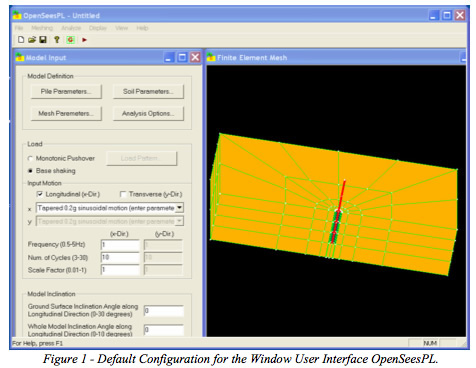
OpenSeesPL allows for selection of soil materials from an available menu of cohesionless and cohesive soil materials (Figure 6). The menu of soil materials (Table) includes a complementary set of soil modeling parameters representing loose, medium and dense cohesionless materials (with silt, sand or gravel permeability), and soft, medium and stiff clay (J2 plasticity cyclic model). Representative soil properties are pre-defined for each of these soils (Table). The theoretical background is discussed in Parra (1996), Elgamal et al. (2002a; 2002b; 2003), and Yang (2000; 2002; 2003).
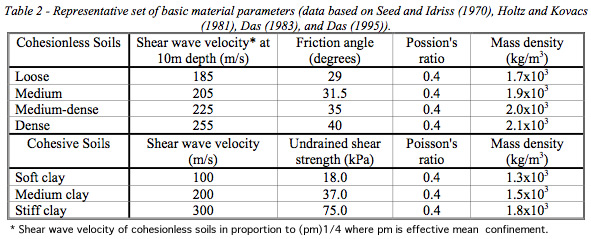
OpenSeesPL also allows users to control soil parameters such as yield strength (Su) for instance, making the definition of properties as simple as the user wishes and the situation demands. In addition, appropriate windows can be created for users to include their own material models (Figure 7) in OpenSees, and access these materials through the finite element program OpenSees (McKenna 1997; McKenna and Fenves 2001).
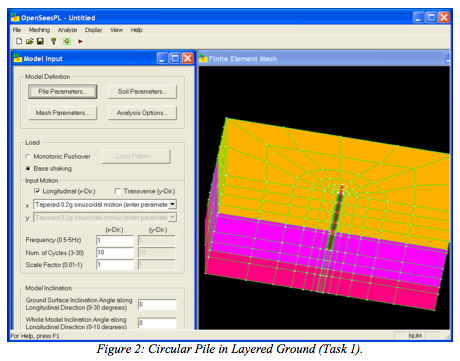
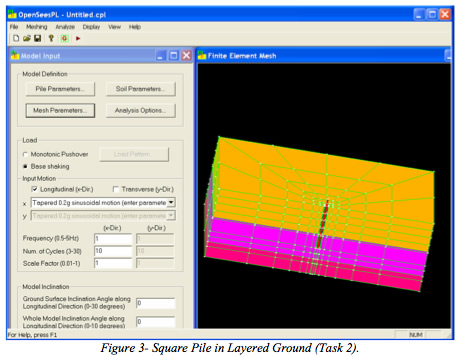
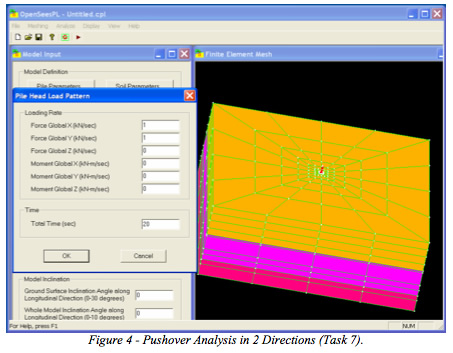

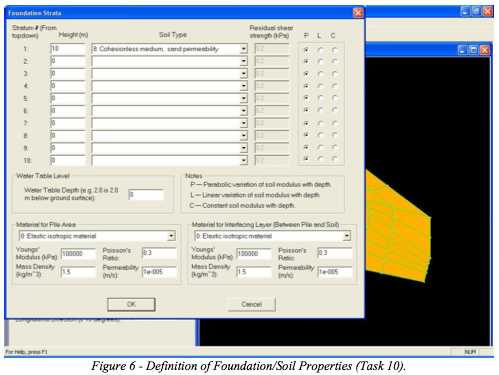
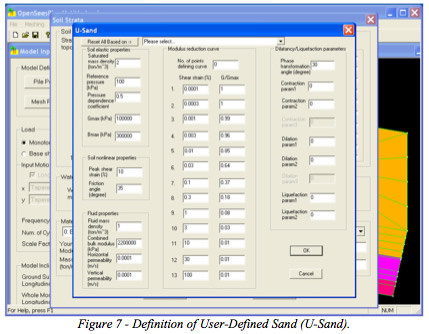
ONGOING WORK
Currently, a user manual is being prepared including documentation for 2 response scenarios to be defined in collaboration with Caltrans engineers.
REFERENCES
- B.M. Das. (1983). Advanced Soil Mechanics, 2nd Edition, Taylor and Francis Publisher, Washington, DC.
- B.M. Das. (1995). Principles of Foundation Engineering, 3rd Edition, PWS Publishing Co., Boston, MA.
- A. Elgamal, E. Parra, Z. Yang, and K. Adalier. (2002a). "Numerical Analysis of Embankment Foundation Liquefaction Countermeasures." Journal of Earthquake Engineering, 6(4), 447-471.
- A. Elgamal, Z. Yang, and E. Parra. (2002b). "Computational Modeling of Cyclic Mobility and Post-Liquefaction Site Response." Soil Dynamics and Earthquake Engineering, 22(4), 259-271.
- A. Elgamal, Z. Yang, E. Parra, and A. Ragheb. (2003). "Modeling of Cyclic Mobility in Saturated Cohesionless Soils." International Journal of Plasticity, 19(6), 883-905.
- R.D. Holtz, and W.D. Kovacs. (1981). An Introduction to Geotechnical Engineering, Prentice Hall, Englewood Cliffs, NJ.
- F. McKenna, and G.L. Fenves. (2001). "OpenSees Manual." PEER Center, http://OpenSees.berkeley.edu.
- Frank T. McKenna. (1997). "Object-Oriented Finite Element Programming: Frameworks for Analysis, Algorithms and Parallel Computing," Ph.D. Thesis, Department of Civil Engineering, University of California, Berkeley.
- E. Parra. (1996). "Numerical Modeling of Liquefaction and Lateral Ground Deformation Including Cyclic Mobility and Dilation Response in Soil Systems," PhD Thesis, Department of Civil Engineering, Rensselaer Polytechnic Institute, Troy, NY.
- H.B. Seed, and I.M. Idriss. (1970). "Soil Moduli and Damping Factors for Dynamic Response Analyses." Report EERC 70-10, Earthquake Engineering Research Center, University of California, Berkeley, CA.
- Z. Yang. (2000). "Numerical Modeling of Earthquake Site Response Including Dilation and Liquefaction," PhD Thesis, Department of Civil Engineering and Engineering Mechanics, Columbia University, New York, NY.
- Z. Yang, and A. Elgamal. (2002). "Influence of Permeability on Liquefaction-Induced Shear Deformation." Journal of Engineering Mechanics, 128(7), 720-729.
- Z. Yang, A. Elgamal, and E. Parra. (2003). "A Computational Model for Cyclic Mobility and Associated Shear Deformation." Journal of Geotechnical and Geoenvironmental Engineering, 129(12), 1119-1127.
Back to Funded Project Archive main page

